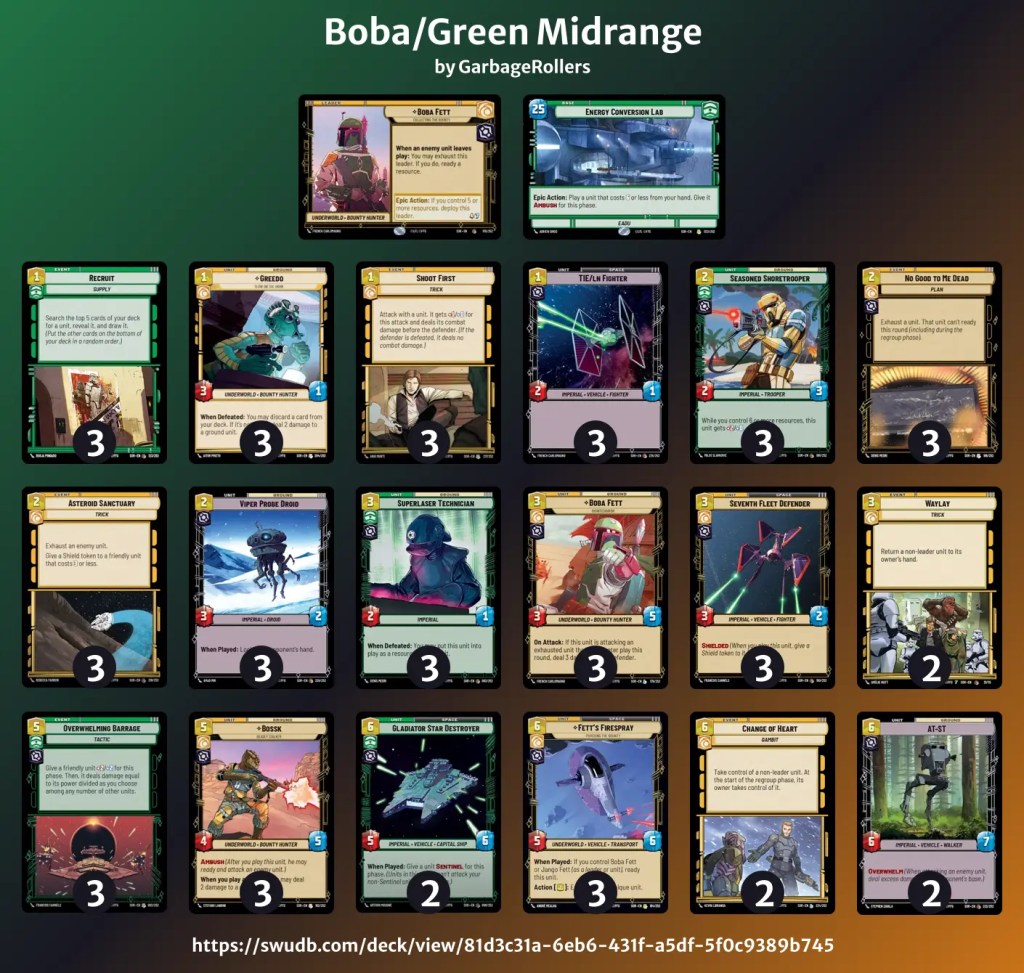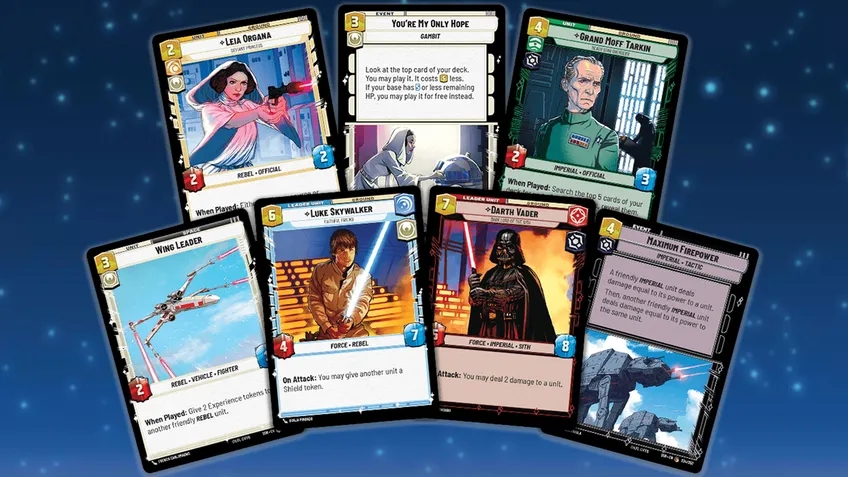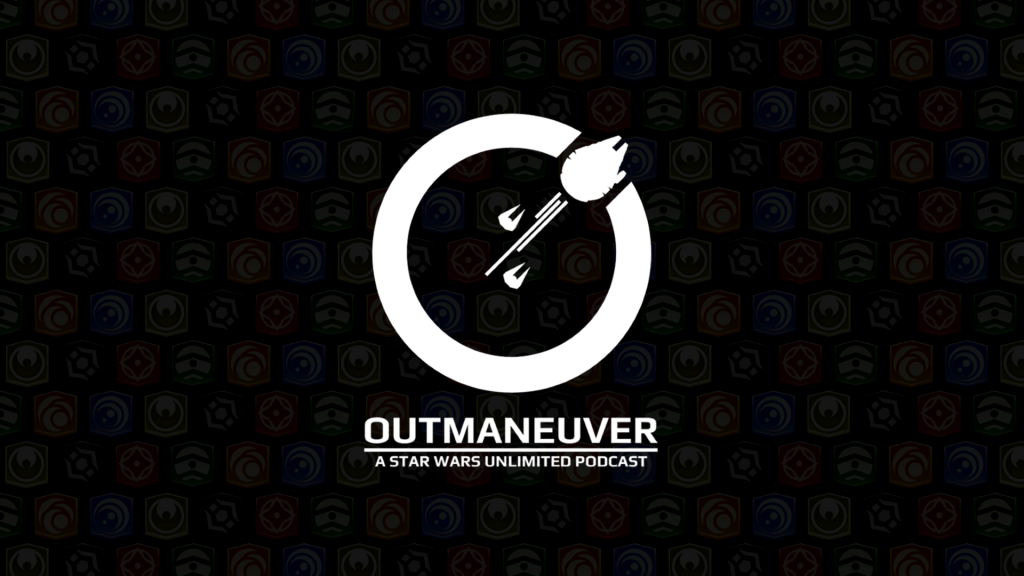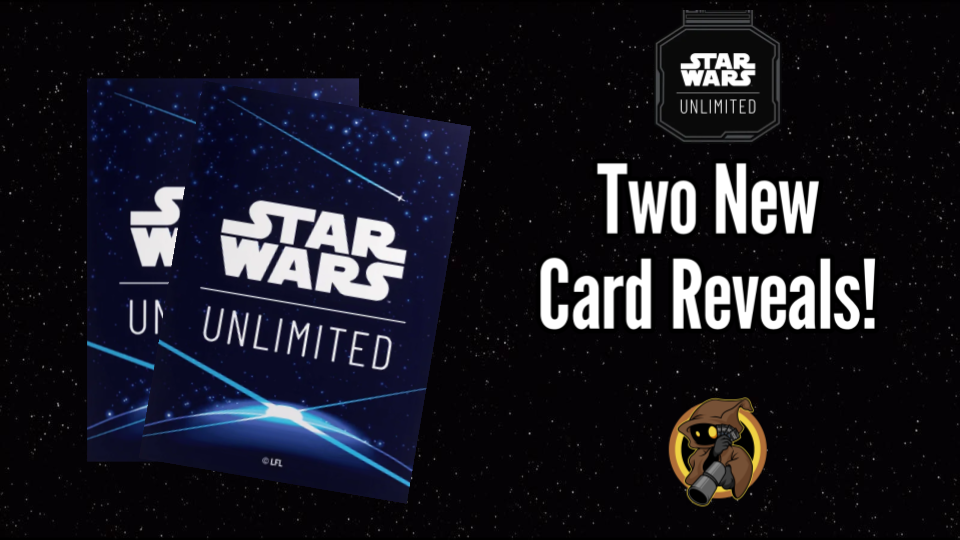Assuming you’re not a Spike, as Tyler outlined earlier in the Player archetypes article, you’ll spend more time on deck building than anything else (apart from playing potentially) in Star Wars: Unlimited. Leaders have interesting dynamics, but so do the other cards… So, how should we start deckbuilding? I like to start with one of four options in Star Wars Unlimited at the Macro level.
- Picking a leader and building around that leader.
- Picking an archetype first, then a leader that supports it, and building the deck around both of those.
- Picking 3 colors that complement each other well.
- Finding the best value cards in the game and building around them.
From there we move to the Micro level, where I typically follow this path:
- Fill out my Round 1 plays (11 or 12 minimum 1-2 cost units)
- Fill out 6-9 late game bombs to help me close the game
- Add 3-12 removal cards
- Generally events, but can also be upgrades or units
- Fill out the list with middle-cost options, synergy cards, and ensuring enough cards in each category.
- This can vary by the archetype of deck, but a rough pass is:
- 18-27 ground units
- 8 -15 Space units
- 6 -12 events
- 0-9 Upgrades
- This can vary by the archetype of deck, but a rough pass is:
Picking and building around a leader
Pretty self-explanatory- you really want to play your favorite star wars character Darth Vader or Luke Skywalker.
Let’s go through the process with Luke Skywalker! Shields seem strong and can create sequencing and tempo issues for your opponent. We also want to look for ways to get Luke on the board faster and keep him there once we deploy him. This allows you to setup a strong shield engine with Luke attacking, creating value trades, and taking over control of the board. We definitely want to build Luke as a midrange deck that wants to take control of the board around Round 5-6 and close the game out from there.
With that in mind, we’ll pair him with green to give us some resource ramp in Resupply and early game board stabalization with the Energy Conversion Lab base. We generally look for at least 11 or 12 1-2 cost units to give us a Round 1 play. R2-D2 is a fantastic 1 resource unit that gets shieled round 1, allows us to push through our deck quicker if we want to send matchup dependent cards to the bottom, and presents a nice option for an upgrade Round 2 if we want to fight for board control that way. From there, Battlefield Marine is the easy value pick as a vanilla 3/3, 2-cost unit that can trade into a lot of opponent’s round 1 plays and survive. We’ll round out to that magical 12 number with the Restored ARC and Alliance X-Wing for some cheap space options.
We’ll then move to the top end where we want a few options. We love Luke, so adding Luke Skywalker as our first bomb! He has a strong “When Played” ability and synergizes with our Force cards. With Green, we can take Home One along as a Space bomb and wrap up by adding Obi-Wan Kenobi to help protect Luke Skywalker on his deploy round.
There’s not much in the way of events for Hero Vigilance currently, so we’ll add Takedown as our most flexible removal card. We’ll then turn to It Binds All Things to combo with Force units.
For more board control help, we want to include some copies of Entrenched and Jedi Lightsaber since we plan on running several force units. Entrenched is especially awesome as a potential upgrade to play on an opponent’s big space unit if we don’t have other ways to prevent it from hitting base. We also want to include a couple of copies of Luke’s Lightsaber with the huge swing potential they have when played on either of our Lukes!
To fill out our deck, we start by adding Bright Hope as some middle-game space protection. Yoda and Kanan are no-brainers to synergize with our force cards and give us some restore early game. To fill out or last slots, we want a few more ground units, so Admiral Ackbar fits that bill with his On Play ability & restore. Wilderness Fighter comes into play with a shield and has some interesting synergy with Energy Conversion Lab in an annoying way to your opponent (Ambush and Shielded keyword are the same timing window, so you can ambush in and take damage on your unit before gaining the shield which is more annoying to deal with in most scenarios).

Here’s our final result! If you’re reading this in the future when we have far more than half a set spoiled, you might think my picks are insane, so keep the timing of this article in mind!
Picking an archetype first, then a leader that supports it, and building the deck around both of those.
There are 3 major card game archetypes: Aggro, Midrange, and Control. Here’s a quick breakdown in how they vary:
- Aggro (short for “aggressive”) decks attempt to reduce their opponents to 0 life as quickly as possible, rather than emphasize a long-term game plan. Aggro decks focus on converting their cards into damage; they prefer to engage in a race for tempo rather than a card advantage-based attrition war. They are all about swarming the board with cheap units and finishing the game before their opponent can turn the tide.
- Midrange decks are about playing high-value and efficient cards. These decks play a more attrition-based game against aggro decks, before swinging the tide and closing the game. Against Control decks, Midrange looks to be more pro-active and aggressive knowing that the game cannot go on too long.
- Ramp decks are fairly similar to midrange decks, but they look to play cards like Resupply and Superlaser Technician that create a resource advantage, leading to them playing bigger, badder units than their opponent. If Ramp decks fail to ramp, they’re typically in a terrible position.
- Control decks are the weakest and slowest early game decks. They’re looking to use lots of removal cards and survive to the late game where they can overwhelm their opponent after taking advantage in resources, hand size, and/or the battlefield.
- Combo decks look to draw into certain card combinations that synergize strongly and can either: win the game in one swing when played together or setup an engine that wins the game. Currently the closest thing we have in Star Wars Unlimited for this archetype is the Grand Inquisitor, who can ready a unit and potentially swing 3 times in one round with it on the round he deploys to the battlefield.
If I were to decide I wanted to play the Aggro archetype, I would look for a leader like Sabine Wren, who deploys at the lowest resource cost in the game (4), and supplement her with lots of cheap efficient hero units like Green Squadron A-Wing, Red Three, and the Sabine Wren unit.
If I wanted to build a midrange deck, I’d look to a leader like Luke Skywalker, who can generate lots of value through the creation of Shields. You could also add strong synergy Force units like Yoda and Kanan Jarrus who have Restore abilities as well.
With little over half the card pool, there’s some obvious choices for which Leader fits each archetype the best. In the future, we will see more great options that allow you to build out each archetype differently!
Picking 3 colors that complement each other well
Since the card pool is so small, it’s hard to say for sure what this will look like. So far Blue seems strong in the midrange & control, Yellow has tricky events, Red has cheap, aggressive units, and Green has many big, late-game units & access to most of the ramp cards in the game.
This leads me to believe we will often see Red (Aggression) & Yellow (Cunning) decks together, while Blue (Vigilance) & Green (Command) will be more of a natural fit as well.
I’m definitely not saying thats the only way you will see these aspects paired, but I won’t be surprised if they are the most common.
Finding the best value cards in the game and building around them
Looking through the current card pool, cards like the Boba Fett Unit, Shoot First, DJ Deathstar, Bossk, Greedo, No Good to Me Dead and Overwhelming Barrage look like great cards to build around! Boba is a few health above what I’d expect the standard 3 cost unit to have, and then adds in a pretty sweet first strike ability. Shoot First is a super-efficient surprise effect from hand that helps with board control while keeping my unit alive for only 1 resource. Superlaser Technician provides some great ramp help. He’s a chump blocker I can get some value out of by hitting an opponent’s unit for 2 and then cheating ahead on the resource curve.
Bossk comes in with ambush and a 4/5 body that should survive anything you’d want him to swing into. After that he retains great value giving you a free 2 damage to deal every time you play an event. Greedo is the best 1 cost unit in the game with a 3/1 body that can potentially trade up into a 5 health unit or 2 units on the opposing side in the right circumstances thanks to his When Defeated ability. No Good to me Dead exhausts a unit for 2 rounds and it can be a leader! Overwhelming Barrage currently looks to be THE primo board control card while also giving us a temporary stat boost.
Building around these cards leaves us wanting a Villain Yellow/Green setup. From there we can choose between Grand Moff Tarkin or Boba Fett as our leader before we start to fill out the remaining cards to fit that dynamic. If we choose to run Boba, then we’re probably adding in another strong synergy card with him like Fett’s Firespray and complementing our deck from there.
After we fill out with a few more cards, we’re left with this:

Hopefully this leaves you with some basic steps for deckbuilding. Like playing the game, the more you practice, the better you will get. Bonus points, playing the game will also show you some deckbuilding aspects that synergize better with your playstyle than other players.
If you didn’t know these existed, here are the Deckbuilder websites available for Star Wars Unlimited that you can start deckbuilding with:
- SWUDB (We use this one)
- Star Wars Unlimited DB
- sw-unlimited-db






Leave a comment